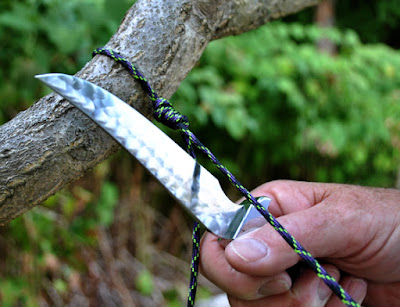It was obvious from the start the Great Lakes Knife Show was in for trouble from the beginning. Our GPS lead us to an empty lot on the Rock River. It was only because we looked around and saw a building on a bluff overlooking the river that we found the place.
We stayed in Rockford, IL and came up I 90. There was one sign that said “Knife Show” at the exit and then there were none. Zero.
We drove around several closed businesses until we found a mini traffic jam in a parking lot. We knew then we found the knife show. The facilities were great. Wide aisles, clean rest rooms, limited food menu. How limited? Only one choice of the same sandwich for meals each day. Let’s forget the food; we were there for the knives.
 |
| We arrived early and set up in anticipation of non-existent customers. |
There were a lot of vendors. A surprisingly large number of young men forging and make knives.
We were next to Gravelle Knives. Josiah Gravelle has spent the last ten years making knives. As he told me, beats having a real job. Most of his sales are on the internet and he uses Facebook and Snapchat.
 |
| GT-1. One of Josiah best sellers. It's a half inch thick slab of A-2 steel. |
Snapchat is especially interesting to me. It’s a novel advertising media. Snapchat, for us oldsters, is an app for mobile devices that allows users to post videos and images for, as I understand it, 24 hours before it self-destructs. That’s a useful feature if you want to post that image of yourself drunk out of your mind, running around pantless wearing your undershorts on your head. Not the kind of thing you want future employers to find.
Snapchat claims they reach 41% of the 18-34 year olds in the nation. Interesting….
 |
| Yeah, it's a crappy picture but the knife is a half inch thick and Josiah sells everyone he makes. |
Facebook. Most of you know Facebook and you realize that it is one of the preferred modes of communication in the digital age.
Unfortunately, the Great Lakes Knife Show only started utilizing these two modes of advertising the day of the show and not in advance. While they utilized older models like the internet, printed flyers and printed media, they just didn’t get the play they wanted.
As a result the show was poorly attended and sales, the reason for the show, suffered.
I think I know how Uti-bebic felt in 2000 BC when he was told nobody used clay tablets anymore and parchment was in!
I also spent time with Mr and Mrs. Biggins and their knives. They had forged knife I wanted in the worse way, but I doddered and then I diddered and before I knew it, it was gone. They too don’t use a website, but rely on Facebook and Snapchat to introduce their knives and sell them.
The message is clear to me. If you’re trying to establish and grow an activity or business and you’re not utilizing the new electronic media you’re fubared.
The second knife/gun show was the Medina show. It’s a regular for me. The weather was wonderful and sales were slow. Not atypical outcome in early October. I did have several interesting conversations.
The one I remember the best was about a knife collection. Frankly, nobody ever talks about small collections, only large ones. It must be a manhood measuring kind of thing. He had a big one, he said. It was so big in fact he told me, “I have knives I’ve never seen.” Maybe he has buyers make purchase for him and they go directly into storage without his inspection. I wonder how many empty boxes he has been sold.
One common thread at any gun or knife show is counterfeits.
While I was at Great Lakes Knife I came across a box of loose Bear and Son butterfly knives marked “Your choice, $50.” They were box less and looked like Bear Song IV knives. They retail for around $137. Now, I’m a dealer and I understand wholesale prices and if we assume the seller breaks even, $50 is impossibly below the wholesale cost.
These were counterfeit. And it harms the knife industry and each consumer. You think you’re getting Bear and Son quality, but you’re getting a piece of shit. Bear and Son takes it on the chin because the knock-off doesn’t hold an edge, breaks when you need it, or falls apart in your pocket.
Now, it’s the American way to make something cheaper. Your neighbor makes a widget and after careful inspection you realize you can make one just as good but cheaper. Maybe you discover it doesn’t need level 10 performance, most if not all of that widget’s product life is at level 6 performance. So you make it cheaper, use stronger material, make it lighter, make it different and you put your name on it and go into the market place and announce “My widget is as good as ABC’s widget, but you can save money.”
Soon your customers will tell you which one is more right that the other, unless they get Congress to regulate in their favor.
What you don’t do is announce that your widget is really ABC’s widget and because of some special fast slight-of-hand, you can sell their product cheaper than they can.
You know when you type it out, counterfeits make no sense. Why do they persist?
Maybe it’s idea of easy money. Maybe it the fact that most of us will never do anything, never depend on it, never need performance out of that knife. We just want something to show off while we’re standing by the barbeque while waiting for the burgers to be done. Well, good luck with that.
Kind of a sad commentary, that our adventures require a cheap stage prop.



























